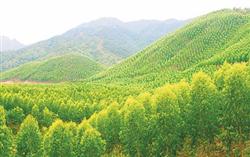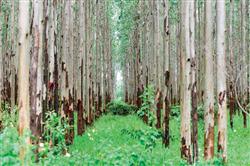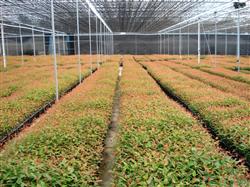How to plant fast-growing eucalyptus trees?

How to plant fast-growing eucalyptus trees? Please introduce the fast-growing eucalyptus planting methods can refer to the following: 1, the variety of eucalyptus belongs to the myrtle family, native to Australia, there are as many as 945 tree species, with a large distribution span and great differences in performance. The excellent clones of Eucalyptus grandis, Eucalyptus grandis, Eucalyptus grandis and Eucalyptus grandis are good in introduction and cultivation, fast growth and high yield, strong adaptability and large extension area in our province. Eucalyptus camaldulensis is more cold-resistant and wind-resistant. 2. Characteristics (1) Eucalyptus grandis and Eucalyptus grandis are hybrid varieties, the former takes Eucalyptus grandis as female parent and Eucalyptus urophylla as male parent, and the latter takes Eucalyptus urophylla as female parent and Eucalyptus grandis as male parent. They like light, grow rapidly, have good dry shape, withstand short-term frost of-3 ℃, and are weak in wind resistance, and are suitable for mountain red soil and latosol red soil with deep, fertile, loose and well drained soil. Eucalyptus grandis has the characteristics of fast growth, high pulp yield and strong adaptability to low altitude dry soil and strong resistance to canker. Asexual reproduction is easy. Clones that performed well in southern Fujian were DH33-27, DH33-22, Dm2-29, DH32-27, DH32-22, DH32-10, DH32-13, Ec1, Ec2 and so on. (2) Eucalyptus grandis is a tall tree with rapid growth, straight trunk and perfect trunk. It is very fond of light, but it is not resistant to heat and can withstand the low temperature of-5 ℃. The main suitable areas are the south subtropical and tropical highlands, with an average annual temperature of 1525 ℃, annual precipitation 1000~1800mn, and typhoon yuan. Under the site conditions, all kinds of loam or clayer soil with deep, fertile and well-drained soil grew best. The clones that perform better in the mountainous areas of southern Fujian are G2, A3 and so on. (3) Eucalyptus camaldulensis is a large tree with straight stem shape, 20-45m height, strong adaptability, lax site conditions, periodic flooding resistance, and can grow normally in dry, barren and deep soil layer. Capable of-5 ℃ short-term low temperature. Strong positive tree species with the characteristics of early rapid growth and poor growth under lack of light or shade. Eucalyptus camaldulensis has deep root, developed main root, solid trunk, sparse leaves and drooping branchlets, so it has strong ability to resist typhoon and can withstand typhoon 11-12. 3. Cultivation essentials (1) selection of excellent clones: DH32-29, DH32-27, DH32-22, DH33-27 of Eucalyptus grandis, Ec1, Ec2 of Eucalyptus grandis, G2 and A3 of Eucalyptus grandis are the best clones in southern, central and western Fujian. Tissue culture seedlings or cutting seedlings should be used for afforestation. In order to improve the survival rate of afforestation, it is recommended to cultivate and plant cuttings in situ so as to avoid damage to seedlings caused by long-distance transportation of seedlings. (2) selection of afforestation site for afforestation technology: hills, platforms, plains and lower parts of low mountains with deep soil layer, loose soil, good drainage, high fertility, slope below 25 °, elevation below 600m and convenient transportation should be selected. The absolute low temperature of afforestation land should be higher than-5 ℃, otherwise it is vulnerable to freezing damage. Woodland cleaning: it should be completed from July to September of the year before afforestation, mainly to split grass and refine mountains, dig out miscellaneous shrub heads and five sections of mango heads. Attention should be paid to fire prevention and soil and water conservation when mountain refining. Termite control: put mirex bait from September to October of the year before afforestation, 225,400 packets per hectare, evenly put in the afforestation land in the shape of "product", appropriate more around the afforestation land, dig deep and small pits of 10~15cm, spread thin layer of withered grass, put 1x2 packets of insecticide into the bag, and cover the soil with compaction. If the control effect is not timely before afforestation, bait can also be applied in April of the year of afforestation, but ant repellent must be applied in the root zone during afforestation. Soil preparation: it should be completed before the end of one year before afforestation, generally using block soil preparation and digging holes to return to the topsoil, with a specification of 70 × 40 × 35cm. The planting points are arranged in the shape of "product". Application of base fertilizer: eucalyptus is very sensitive to fertilizer, and applying base fertilizer is an important measure to build a high-yield forest. When returning to the topsoil about one month before afforestation, the long-term mixed fertilizer of calcium magnesium phosphorus or calcium magnesium phosphorus and the same amount of urea and special fertilizer for eucalyptus were applied with 500g per hole. Base fertilizer can also be used locally, rely on the sea to catch sea fertilizer, rely on the mountain to accumulate green manure. Sea fertilizer 1~2kg and soil fertilizer 2~3kg were applied to each hole. Planting density: generally 1350-1800 plants per hectare. In order to make full use of the growth characteristics of eucalyptus trees favored by side light, the wide row and narrow plant spacing is adopted, and the specification of 2 × 3m is generally adopted. Afforestation season: it should be carried out on cloudy or light rainy days after rain from February to March. Seedling raising and transportation: choose the seedlings with seedling height 10~20cm to go up the mountain for afforestation. Nutrition cup seedlings should be soaked or soaked in water before afforestation on the mountain, and the seedlings that cannot be used on the same day should be drenched and moisturized in the shade shed. Afforestation and planting: when planting, peel off the container or plastic film bag, press the container soil with both hands before tearing the bag, and all the bags should be torn out, not only the bottom but not the edge. When planting compound soil, it should be pressed from all around and put an end to vertical pressure, so as to prevent damage to container soil. When planting, we should be careful not to plant the seedlings on the base fertilizer, so as not to make the roots of the seedlings come into contact with fertilizer and cause "burning seedlings" and affect the survival. We should also pay attention to relaxing the roots and pressing, so that the roots of the seedlings can be closely combined with the soil. Insect control: young roots and stems of eucalyptus seedlings are vulnerable to termites, crickets and small land tigers, especially within three months after afforestation. There are three main control measures: the first is to clean the mountain thoroughly and pick up all the grass roots when returning to the topsoil to cut off the food source of white ants; the second is to apply insect repellent while afforestation (usually not overnight), each plant is applied a small half tablespoon (about 5 grams), pay attention to close around the rhizome, the spraying range is wide, and the effect is poor; the third is to trap and put 1605 mixed powder in the forest land, which has a good control effect on beetles, small tigers and so on. Fourth, the combination of topdressing, carbofuran, ant control. Young forest tending: weeding should be done in time after two months of afforestation in spring, and weeding and loosening the soil again before the weed seeds mature from August to September. In the second year, one or two times of tending should be carried out in the second year, and the young forest can be closed after two years of tending and management. Topdressing: topdressing once in time 1-2 months after planting, once again after rain in July-August, and once in the early spring of the second year combined with weeding and loosening soil topdressing, urea or compound fertilizer should be applied with 100g / plant and 250g per plant each time. When fertilizing, we should pay attention to the following points: first, fertilizing according to the characteristics of soil nutrients, moisture, texture, acidity and alkalinity of woodland and topographical conditions, and removing weeds before each fertilization; second, when applying fertilizer, we should open ditches and bury deeply in the back slope of the hole to reduce fertilizer loss; third, fertilizing after rain to accelerate fertilizer dissolution and reduce fertilizer leaching. Fourth, the barren areas such as ridges and the middle and upper slopes should be applied more, while fertile land such as ditches and valleys should be applied less. Tending thinning: the cultivation goal is short-cycle industrial raw material forest (production of pulpwood). There is no need for tending thinning, but diseased plants and wind-broken trees should be cut and cleared in time. If large diameter wood is cultivated, one or two times of tending and thinning can be arranged. A tending thinning should be arranged 2 ~ 3 years after afforestation in southern Fujian. Sprout regeneration: the operation method of sprout regeneration is one of the characteristics of eucalyptus forest management. ① sprouting and renewal season: winter and spring is the best in the southeast coast. ② finishing of sprouting strips: the first finishing of sprouting strips should be carried out 3 ~ 6 months after clear cutting and when the sprouting strips were as high as 1.5 ~ 2m. The method of removing the weak and retaining the strong was adopted, and 4 trees per stump were left, and after 1-1.5 years of cultivation, the second arrangement was carried out. Finally, 2 fast-growing and sturdy plants were left in the southeast part of the cutting root, and 1800-1950 trees per hectare should be retained. ③ tending and fertilization: after the woodland is cleared, the soil should be loosened to make the soil loose, ventilated and ventilated, reduce the evaporation of surface water, and facilitate the sprouting and growth of cutting roots. Fertilization is carried out before sprouting after cutting, using ditch application method, each plant is applied with phosphate fertilizer or compound fertilizer 1~1.5kg, but also urea, and it is best to apply it together with organic fertilizer under suitable conditions. Click to get more eucalyptus planting techniques click to get more flower planting techniques
- Prev

What is fast-growing eucalyptus?
What is fast-growing eucalyptus? Please introduce eucalyptus to Myrtaceae, eucalyptus [EucalytusSPP.] The general name of tree species is not only one of the three famous fast-growing tree species in the world, but also one of the most valuable hardwood of broad-leaved trees in the world. Native to Australia, there are more than 1000 varieties of eucalyptus in the world.
- Next

What kind of eucalyptus seedlings?
What kind of eucalyptus seedlings? Please give a detailed introduction to guide eucalyptus seedling breeding can refer to the following methods: 1, seedling cultivation 1.1 seedling bed preparation (1) seedbed specification bed width 1.2m, length generally less than 5m, trail width 5cm. (2) after shoveling off the weeds and topsoil from the border, use 25% trichlorfon oil 50.
Related
- Fuxing push coffee new agricultural production and marketing class: lack of small-scale processing plants
- Jujube rice field leisure farm deep ploughing Yilan for five years to create a space for organic food and play
- Nongyu Farm-A trial of organic papaya for brave women with advanced technology
- Four points for attention in the prevention and control of diseases and insect pests of edible fungi
- How to add nutrient solution to Edible Fungi
- Is there any good way to control edible fungus mites?
- Open Inoculation Technology of Edible Fungi
- Is there any clever way to use fertilizer for edible fungus in winter?
- What agents are used to kill the pathogens of edible fungi in the mushroom shed?
- Rapid drying of Edible Fungi

